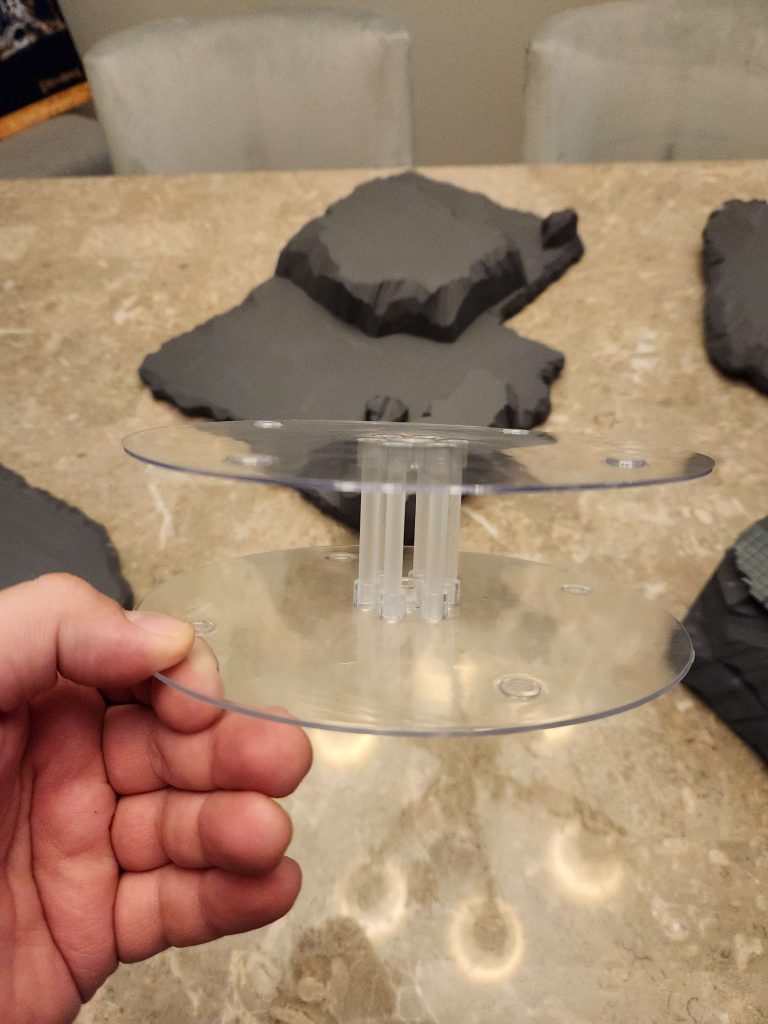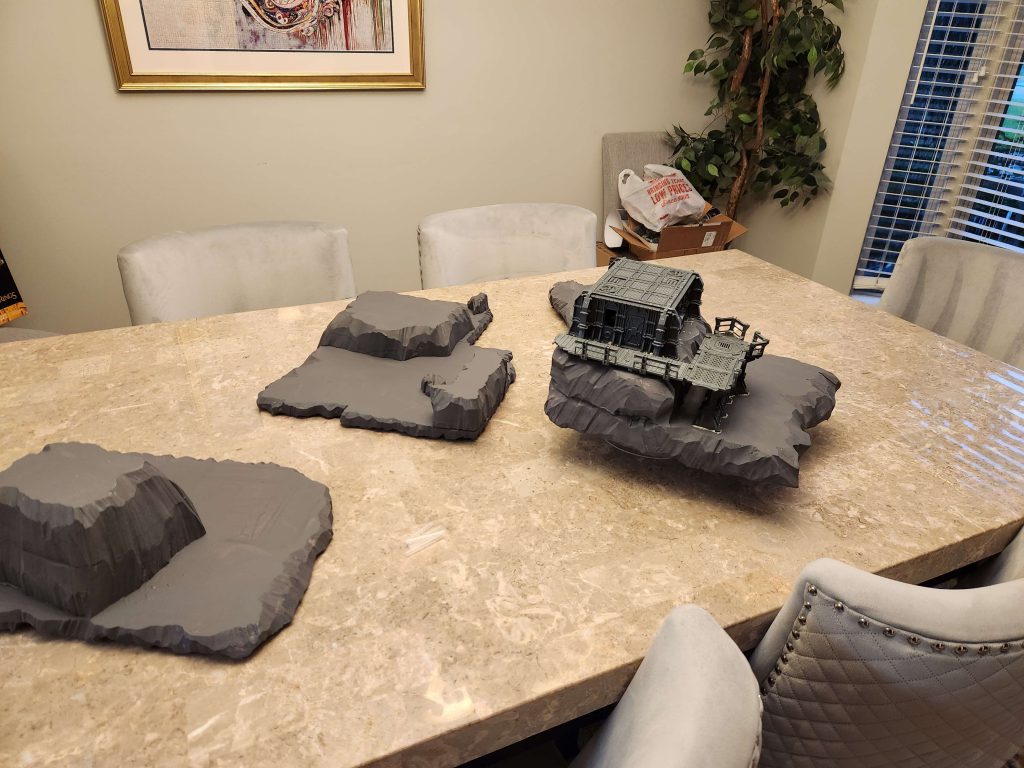In this three-part series of articles we’re looking at how to design, plan, create, and run narrative events. While our examples will be primarily for Warhammer 40,000, we’ll be focusing on lessons that can be applied to any game system.
Welcome back to my series on designing the narrative event for the 2023 Goonhammer Open! Last time around I covered I covered some of the early basics of designing an event, determining the scope and teams, and working through some of the rules we’ll be using. Today I’m going to expand a bit more on the rules and talk about designing the battlefields we’ll be using, and what goes into that. And if you’re looking for tickets to the event, you can find them here – there are still some left!
Step 3: The Battlefields
OK we’ve figured out our scope and we’ve blocked out some of the general rules we’ll be using for the campaign. We don’t have all of those finalized yet – and that’s fine, we don’t need to finalize them at this point, but now it’s time to create the battlefields/fronts our players will be fighting over. In my mind this is one of the most important aspects of a narrative event – the best Narrative events are marked by memorable battlefields and scenarios, with tables and terrain that stand out and stick in the minds of players long after the campaign is over.
As such, I’m of the mind that good Narrative events are largely made or broken by their battlefields, both visually and mechanically. A good narrative battlefield needs a few things to be really successful:
- A visually striking centerpiece or theme – Whether you’re fighting over the wreckage of a crashed ship, in the middle of a hive city, or on the fortified walls of a fortress monastery, your narrative battles should happen on terrain that doesn’t just look like a standard comp table full of MDF.
- Solid missions – Similarly, good narratives are based on clear goals and motivations. You need interesting missions with clearly defined objectives for your players so they feel like they’re making an important contribution to the war effort.
- A memorable rules hook – And finally good Narrative battlefields and missions need an interesting hook to make them stand out. You want something that really makes the battlefield unique, and ideally it’s something tied to the mission and centerpiece/theme.
Ultimately these battlefields live or die based on your ability to tie all of these things together. Today I’m going to talk about one of the battlefields I’m working on for the narrative and run through the process behind that.
Bantavera Station
During the planning process for the campaign I ran through a series of potential battlefields we could run – what we had terrain for, what I wanted to set up, and what we could reasonably build in the 2-3 months prior to the campaign. Generally, we had a lot of terrain from last year’s event that would produce adequate cityfight tables, plus a lot of GW fortifications. We still had the big gun, and we had a bunch of Into the Dark terrain. And we could borrow the walls from the Houston event. That meant figuring out a few more tables on top of all that. One of the tables I wanted to do was a “space table,” where the game play takes place on a series of platforms for players to jump between. While tough to build, this can immediately and easily provide some interesting gameplay opportunities.
I’ve previously done something like this for a smaller narrative game with friends a few years ago, where we used icy hills on a star mat background to generate a compelling space effect for part of the battle. I’ve wanted to do that same thing, only bigger, ever since.

Battlefront: Bantavera Station
Lore Description: An orbital asteroid mining facility where rare metals are mined and sent back to ground facilities for processing.
Why it’s important: As a mining facility, it’s an immediate source of rare materials used to build and repair war machines for the campaign.
Battlefield Description: Bantavera Station consists of a series of disconnected platforms and walkways which armies can jump between. Has lots of space for AIRCRAFT and other flying units to move.
This is a good outline that answers the basic questions and now it’s time to think of a few hooks to make the battlefield pop. Some ideas:
- Floating Platforms – The battle takes place on a series of disconnected platforms in space, requiring units which can move between them. This is a modeling project, involving a black “space” mat and some rocks. Floating possible if I have time, but kind of a pain to implement.
- Low-Gravity – There’s very low gravity on the platforms, making it easy for units to jump around and move between them or get blasted off entirely. This is a rules issue, but I think you can solve it by essentially letting units without FLY move as though they had FLY and let units which already had FLY ignore the vertical movement penalties and end moves on “open” ground. For the other piece I’m thinking of improving the number of shots BLAST weapons get, to reflect the concussive force of those weapons blowing targets off into space with no chance to recover.
- No atmosphere – Not sure yet if I want to model this or have it be a rule. Historically this has been done with AP bonuses, but shooting attacks in 40k do not need help right now so this may be a thing where I improve AP on melee weapons to represent being able to cut/damage air supplies up close.
- Rods from God – As a battlefield control effect, I can let the team holding the asteroid field basically drop meteors down on the planet from orbit, acting as a kind of orbital bombardment. That’s a good way to make holding the territory/winning games matter. Also, it’s cool as hell.
- Aircraft – This is one of a couple of tables where I want to encourage flying and AIRCRAFT units, so AIRCRAFT which aren’t in hover can start on the board.
I’ll still need to come up with some missions for the asteroid facility, but for now these are a good next step.
Building the Battlefield
This is a tough part of the process, because it basically calls for bespoke terrain. Not entirely, in the sense that rocky hills will look just fine on a starfield background (and hence be re-usable), but I do need to have custom terrain made for this.
The Mat
Because this isn’t a textured board – I just need a starfield – a mat is the perfect pick here and that’s where GHO sponsor Tablewar comes in – in addition to prize mats for the event, they also supplied us with a number of discounted mats for terrain. In this case I grabbed the 6’x4′ ‘Space’ gaming mat from them. Yes, 6×4 is larger than a standard 40k table these days, but A. we’re running a lot of megabattles, and B. this will give flyers and AIRCRAFT more room to move around, which is ideal.
The Terrain
After that it’s time to work on the terrain itself. This is tricky – I want to build organic-looking asteroids, but they also need to have large, open flat sections for models to safely stand on. There’s also the mining facility – these need to have both rocks and also the facility.
The rocks are easy enough – I plan to carve up a bunch of pink insulation foam for those. For the facility I need more industrial terrain, and that means Necromunda Ash Wastes, Sector Mechanicus, Zone Mortalis, and Necromunda gang stronghold terrain should work great here, with lots of pieces I can use for creating walkways and gantries and potentially bridges across platforms.
The process starts by picking some sheets of pink insulation foam and carving them into some basic shapes. My goal is to create some hills to hide behind while I do this, but also to make some large, flat areas to play on. One of the central pieces is the mining facility’s main station, which incorporates a walkway and the sector fronteris building. I’m carving these rocks using a wire foam cutter.
From there the next step is to cover these parts with latex paint so I can get them ready for priming later. I’m using gorilla glue to glue stuff to the foam, which sets pretty quickly (though it will cause some separation) and won’t dissolve the foam. After I get the parts on the next step is flocking them with sand and glue, spraying that with scenic cement, and then priming it, painting it, and varnishing it.
While I was in the process of making these I came across some junk in the garage my wife bought: Some kind of floral arrangement stands she got from Amazon as part of a thing where they send you a box of returned junk. I kept them and I’m glad I did because these are absolute fire. I can cut the tubes down to size and then use the stands to create massive stands that can hold the asteroids.

The net effect is a set of sturdy platforms at varying altitudes that really sells the “floating asteroid” effect.
On top of this I found some solid “piles of rock” 3d-printed terrain on Amazon I can add to these to help add to the visual effect of a mining facility, and a 3d-printed landing pad I have will work for sprucing up one of the other asteroids.
There’s still a lot of work to be done but I’m pretty sure I can have it done in the week or two after Tacoma and have it shipped up to Baltimore with plenty of time to spare. Of course, there are other battlefields to handle, but I’ll likely go into more detail on those after the event – I don’t want to give too much away beforehand since I am pretty sure my players will read this.
Generally speaking though, this is a process I’m repeating for every battlefield – each one needs to have distinct elements which will cause them to stick out and be memorable. And while I’m still working on some of those I have about 70% of the rules content done for the campaign at this point. Some territories are easier than others – making the battles interesting on the big gun table take a lot of thought, as the gun itself isn’t all that interesting once you get past the size and scale of it. There’s also the question of how to make a mission dynamic, so if a player plays every game on the same table they don’t feel like they played the same game over and over.
Next Time: Missions and the Player Pack
That wraps up this look at building battlefields but next time we’ll dive into the creation of custom missions and the Narrative campaign player pack. There’s still a lot to cover but hopefully you’re having as much fun reading these as I am writing them. If you’re interested in going to the event, hit that link in the opening paragraph. And if you have any questions or feedback, drop us a note in the comments below or email us at contact@goonhammer.com.









